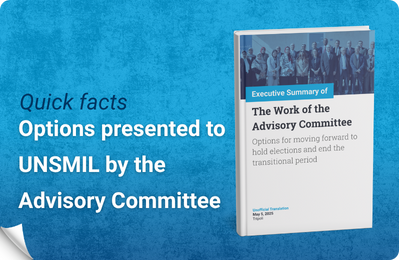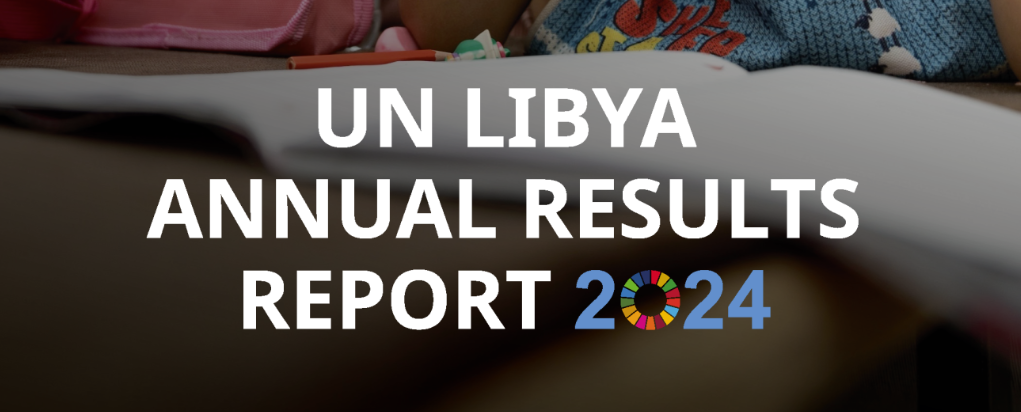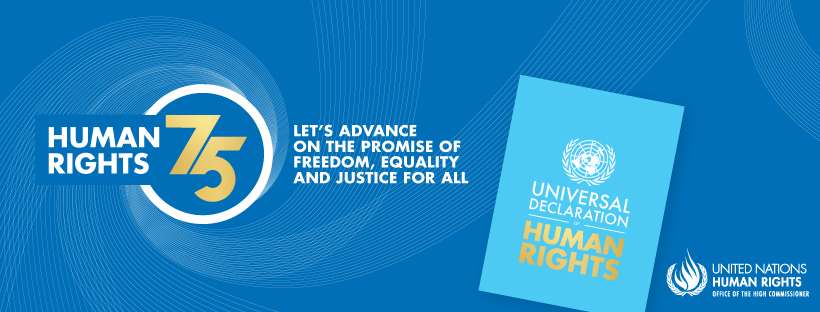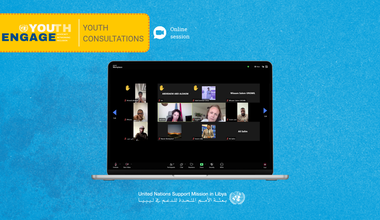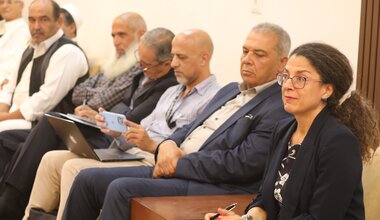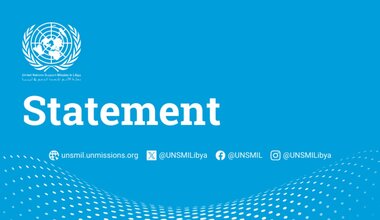Human Rights Report on Civilian Casualties - January 2018
Tunis, 1 February 2018 – From 1 January to 31 January 2018, the United Nations Support Mission in Libya (UNSMIL) documented 102 civilian casualties – 39 deaths and 63 injuries – during the conduct of hostilities across Libya, a sharp rise from previous months. Victims included 33 men, one woman, and five boys killed and 62 men and one boy injured.
The majority of civilian casualties were caused by Vehicle-Borne Improvised Explosive Devices (VBIEDs, 30 deaths and 56 injuries) followed by explosive remnants of war (ERWs, six deaths and five injuries), gunfire (two deaths and two injuries) and shelling (one death).
UNSMIL documented civilian casualties in Benghazi (36 deaths and 63 injuries), Tripoli (two deaths) and Abu Kammash (one death).
This month also witnessed an additional 32 casualties from other violations of international humanitarian law and violations or abuses of human rights in al-Zawiya, Benghazi, Derna and Sabha.
Civilian Casualty Incidents
On 5 January, a 50-year-old Algerian national sustained fatal gunshot wounds in the crossfire during armed clashes in the area of Abu Kammash between forces under the command of PC-appointed Major-General Ossama Jweili and local armed groups.
On 15 January, an armed group from Tajoura under the command of Bashir al-Bugra launched an attack on the Mitiga airport, controlled by the Special Deterrence Force. At least two civilians, a 51-year-old female employee of a commercial airline and a 91-year-old male resident of Tajoura, were killed in the ensuing fighting, which spread to residential areas west of the airport. UNSMIL was unable to ascertain the civilian status of any of the injured.
On 23 January, a twin bombing in front of the Bi’at al-Radwan mosque in Benghazi led to a heavy civilian casualty toll. The first car bomb was detonated as worshippers were leaving the mosque following evening (isha) prayers. The second car bomb exploded some 20 minutes later after rescuers had rushed to the scene of the attack. According to medical and military sources in Benghazi, at least 30 civilians were killed, including three boys and an employee with Libaid, a humanitarian organization. At least 56 civilians were admitted to hospitals for treatment for injuries sustained during the attack. Some 40 others received emergency first-aid. A member of the Libyan Red Crescent was among those injured in the attack.
ERWs continued to claim lives and maim civilians in Benghazi neighbourhoods that have witnessed protracted fighting, including Souq al-Hout and al-Lithi. Between 4 and 30 January, four men and two boys were killed and four men and one boy injured when unknown explosives detonated. This included an incident on 30 January where two boys, aged 10 and 11, were killed and a 13-year-old boy was injured in an ERW explosion in a street in al-Lithi.
Civilian Facilities
On 22 January, armed men reportedly affiliated to the LNA opened fire at the main entrance of the Benghazi Medical Center resulting in the injury of two hospital employees. An alleged perpetrator was reportedly detained by the military police in Benghazi.
A number of commercial planes were damaged in the attack on the Mitiga airport on 15 January, which was closed for a number of days.
Attribution
The Benghazi Revolutionaries Shura Council and allies are believed to have been responsible for leaving mines and ERWs in areas of Benghazi they controlled prior to their retreat.
No group claimed responsibility for the deadly attack on the Bi’at al-Radwan mosque in Benghazi.
UNSMIL was unable to determine with certainty which parties to the conflict had caused the other civilian casualties in January.
Casualties from other violations of international humanitarian law and violations or abuses of human rights
On 3 January 2018, unidentified assailants fired shots at the director of the Department of Education in al-Abyar at his home. He died from his injuries the next day. He reportedly received death-threats after announcing his candidacy for parliamentary elections.
On 14 January, a 13-year-old boy was riding in a vehicle in central Sabha on his way back from school, when unknown assailants opened fire in an apparent attempted car-jacking, leaving him fatally wounded.
On 20 January, a dispute between participants at an event organized by youth in southern al-Zawiya to promote reconciliation between tribes escalated into armed clashes, leaving one man dead and another injured. UNSMIL has not been able to ascertain their civilian status.
On 24 January, still images and a video emerged on social media purportedly depicting a field commander with the Special Forces, Mahmoud al-Werfalli, shooting point-blank 10 blindfolded men dressed in blue overalls, as they knelt down with their hands tied behind their backs. Their bodies were then loaded into the back of a pick-up truck in front of a large crowd of onlookers. On 15 August 2017, the Pre-Trial Chamber 1 of the International Criminal Court issued a warrant for the arrest of Mahmoud al-Werfalli, for the war crime of murder.
On 24 January, the bodies of two men bearing gunshot wounds were found in a rubbish dump in Benghazi. The two were blindfolded and had their hands tied being their backs. On 26 January, five bodies were found in the area of al-Lithi in Benghazi, bearing gunshot wounds including to the head. Sheets of paper entitled “Identification of Khawarij” with the men’s names, addresses and alleged crimes against the “army and police” were found next to the bodies. Warnings to families not to hold funeral services were also written on these papers. According to information received, two of the five victims were taken from their Benghazi homes by groups of masked armed men on 23 and 25 January, respectively.
On 25 January, the bodies of three men bearing gunshot wounds were brought to the Herish Hospital in Derna. A video posted on Facebook pages, affiliated to the Derna Mujaheedeen Shura Council, showed at least one of the men being interrogated by an unidentified individual about his alleged support to the LNA.
On 27 January, unknown armed men opened fire at a Sabha café frequented by Tabu residents, leaving three men injured. On 28 January, unknown armed assailants attacked a shop in the area of Mahdia, shooting dead its owner before setting the place ablaze. On the same day, 28 January, unidentified armed men opened fire on the Sabha headquarters of the Installation Guards, killing two policemen and injuring another. The body of an Awlad Sliman member of the 6th Brigade was also found on 28 January in Sabha. He had been seized by unknown perpetrators days earlier from outside the Brigade’s base.
Note
The figures for civilian casualties set out above only include persons killed or injured in the course of hostilities and who were not directly participating in the hostilities. The figures do not include those casualties that are not a direct result of hostilities, for example executions after capture, torture or abductions, or casualties caused as an indirect consequence of hostilities. The figures are based on information UNSMIL has gathered and cross-checked from a broad range of sources in Libya, including human rights defenders, civil society, current and former officials, employees of local governments, community leaders and members, witnesses, others directly affected and media reports. In order to assess the credibility of information obtained, where possible, UNSMIL reviewed documentary information, including medical records, forensic reports and photographic evidence.
The figures are only those that UNSMIL was able to document in the reporting period. They are not likely to be complete and may change as new information emerges about incidents involving civilian casualties that took place during this period.
Similarly, while UNSMIL has systematically tried to ensure that the cases it documented are based on credible information, further verification would be required to attain a higher standard of proof. Due to the security situation, UNSMIL has not been able to carry out direct site visits to all relevant locations in Libya to obtain information. Fear of reprisals against sources further hamper information gathering.
While not all actions leading to civilian casualties breach international humanitarian law, UNSMIL reminds all parties to the conflict that they are under an obligation to target only military objectives. Direct attacks on civilians as well as indiscriminate attacks – which do not distinguish between civilians and fighters – are prohibited. Attacks that are expected to cause incidental loss of civilian life, injury to civilians and damage to civilian objects excessive to the anticipated concrete and direct military advantage are also prohibited. Such attacks amount to war crimes that can be prosecuted by the International Criminal Court.
In order to ensure greater protection of the civilian population and essential infrastructure, all parties engaged in fighting in Libya must cease the use of mortars and other indirect weapons and imprecise aerial bombardments in civilian-populated areas, and not place fighters or other military objectives in populated areas. All executions of captives must cease and all those captured including fighters must be treated humanely in all circumstances. Murdering or torturing captives is also a war crime, regardless of what the captive may be accused of.
Cases highlighted in the “other casualties” section include casualties caused during incidents that would constitute a violation of international humanitarian or human rights law, but are not a direct result of hostilities, for examples executions upon capture of civilians and others hors de combat (such as captured fighters) and torture causing death. The section also includes casualties caused by the proliferation of weapons and impunity enjoyed by armed groups and criminal networks – considered as indirect consequences of hostilities. Cases highlighted in the “other casualties” section are not included in the figures for civilian casualties and include only those that UNSMIL documented during the month.
 United Nations Peacekeeping
United Nations Peacekeeping UN
UN



